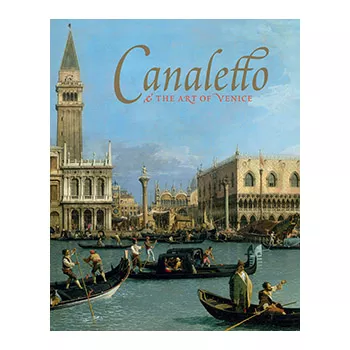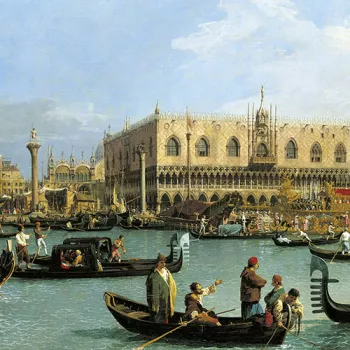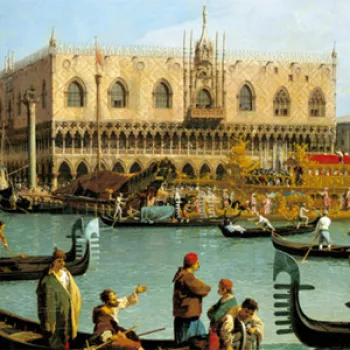A Regatta on the Grand Canal c.1733-4
Oil on canvas | 77.1 x 125.7 cm (support, canvas/panel/stretcher external) | RCIN 404416
-
This and another picture, The Bacino di San Marco on Ascension Day (RCIN 404417), form a pair, much larger than the other twelve views on the Grand Canal, and were engraved as the final two plates of Visentini's Prospectus Magni Canalis Venetiarum (Venice, 1735), thus providing an uncontested date for completion. Visentini's engravings are based on Canaletto's series of Grand Canal views which were all at one time in the collection of Joseph Smith and are now in the Royal Collection.
The view is of the entire central stretch of the Grand Canal, looking north-east from Ca' Foscari towards the Rialto, which can just be seen in the far distance. Races along the Grand Canal had been held annually on 2 February, the feast of the Purification of the Virgin, since 1315, and occasional regattas were also held to entertain distinguished visitors to Venice. The course ran from the Punta di Sant'Antonio at the south-east of the island, along the Riva and Molo, up the Grand Canal to Santa Croce, then back to the Volta di Canal at Ca' Foscari, a distance of some eight kilometres. The finishing line at the mouth of the Rio di Ca' Foscari was marked by the macchina della regatta, a canopied pavilion floating on a raft tethered to moorings, seen here in the left foreground.
The balconies and windows are hung with coloured cloths; spectators, many in the carnival bauta of black cape and white mask, crowd the buildings and the boats, including the ceremonial bissone of the noble families, that line the canal. To the left is Palazzo Balbi, to the right, Palazzo Nani-Mocenigo, followed by Palazzo Contarini delle Figure and the complex of the Palazzi Mocenigo, (the two palazzi known as 'Casa Vecchia' and 'Casa Nuova' each surmounted by a pair of obelisks). Catching the sunlight beyond are the sides of Palazzo Corner-Spinelli and Palazzo Grimani. The tower and dome of San Bartolomeo sit on the skyline at the far end of the canal.
Canaletto based his composition on a painting of 1709 by Luca Carlevarijs (Frederiksborg Castle, Denmark), but opened out the right bank and diminished the distance to make the race more dramatic. Levey pointed out that the coat of arms on the macchina is that of Carlo Ruzzini, Doge from June 1732 to January 1735, and therefore the painting must ostensibly depict the regatta of 1733 or 1734. From the macchina a figure dressed in yellow turns to look straight out of the painting at the viewer, and it has been speculated that this may be a portrait of Joseph Smith, whose likeness is not known. Naturally, the regatta was a popular subject, and Canaletto and his followers turned out many versions of the scene.
Catalogue entry adapted from Canaletto in Venice, London, 2005Provenance
Acquired in 1762 by George III from Joseph Smith, British Consul in Venice (Italian List no 104); recorded in the Gallery at Kew in 1805 (no 5)
-
Medium and techniques
Oil on canvas
Measurements
77.1 x 125.7 cm (support, canvas/panel/stretcher external)
99.3 x 146.7 x 11.5 cm (frame, external)
Other number(s)
Alternative title(s)
Boat race from the Balbi Palace to the Rialto, Venice













